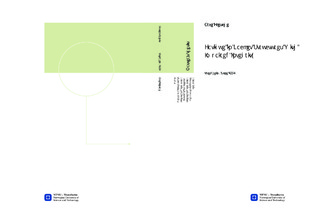| dc.description.abstract | Present regulations for offshore structures on the Norwegian continental shelf havea requirement for Accidental Limit State redundancy and Fatigue Limit State redundancyin a damaged state. However, the requirement is far more defined forthe Accidental Limit State than for the Fatigue Limit State. An increased understandingof factors governing fatigue redundancy would create a basis to form acomprehensive definition.In literature, the term redundancy is defined in several ways. The different methodscan be divided into two major categories, namely deterministic and probabilisticapproaches. In general, redundancy may be defined as the absence of memberswhose failure would lead to global collapse. Within both the deterministic and theprobabilistic framework, several redundancy factors are usually defined, and thereare resemblance between some of them. In probabilistic methods, the reliabilitymethod is commonly applied through the First Order Reliability Method.Fatigue damage is a primarily concern regarding the integrity for offshore structures.A near constant subjection to cyclic loadings from wind, current and wavesinitiates a cumulative damage process which leads to a certain fatigue life for themembers in the structure. The lifetime may be calculated using either a fracturemechanics approach or a SN-curve approach. There exists several approaches tocalculate the stress levels to be used in the fatigue analyses, and the choice ofmethod is mainly based on whether or not the structure under consideration isdynamically behaving or may be regarded as quasi-static. Also, there may be nonlinearitiesthat needs to be accounted for and naturally this will affect the choiceof analysis method. However, large uncertainties are associated with fatigue calculationsregardless of analysis approach. Thus, a probabilistic framework is highlyrelevant in order to estimate the risk of failure due to fatigue.A study on how impaired integrity affects the fatigue life has been performed fortwo jackets; one highly redundant four-legged jacket and one less redundant threeleggedjacket. The main goal has been to investigate the fatigue redundancy of thestructures, in order to link up the risk of accelerated fatigue due to damage withthe risk of failure due to extreme environmental actions, which may eventually leadto structural collapse. A stochastic fatigue analysis approach was chosen, and theanalyses was in agreement with the standards governing the Norwegian continentalshelf at the time of this thesis. Pushover analyses has been performed on the jacketsto give an insight in their redundancy, and a calculation of changes in the naturalperiods under impaired integrity has also been done.The four-legged jacket was proven to be highly redundant, and had small changesin the natural period under impaired integrity. The three-legged jacket on the otherhand, had some damage cases with a rather large increase. Also, the redundancyfactor R4 was significantly lower for the three-legged jacket, thus confirming it tobe less redundant than the four-legged jacket. A large change in the natural periodwill alter the dynamic response, thus the fatigue life is vastly connected to changesin global stiffness.Trying to explain the changes in fatigue life for the two jackets under impairedintegrity without using a deterministic approach, i.e. calculate the fatigue life forthe specific damage case, was proven to be very difficult. There seems to be noeasy way to isolate the severity of the fatigue life reduction since large changesare occurring throughout almost the entire structure for several damage cases, aswell as large spread in the values them self. However, there was also found sometrends in the results. One of them, was that the closer a member is to the damagedelement, the larger is the expected reduction in fatigue life. Another trend, is thata large fatigue accelerator factor is expected in almost every damage case, thus onemay expect large changes for most of the damage scenarios.Another vastly occurring phenomenon were the location of the damaged memberswho gave the lowest fatigue life in the structures. For the four-legged jacket, thisinvolved damage in the caisson supports. The three-legged jacket, however, hadthe lowest fatigue lives occurring for damage cases in the top frame where there isa lack of deterministic redundancy.There seems to be no fatigue redundancy for the jackets, as there are large fatigueaccelerator factors occurring. There is also the very low calculated fatigue life inthe most extreme cases. However, there has been found a slight correlation betweena large reduction in fatigue life and a large initial fatigue life. What should also betaken into account though, is both the risk related to the fatigue lives found, andthe accuracy of the values due to the linearised analysis. | nb_NO |

